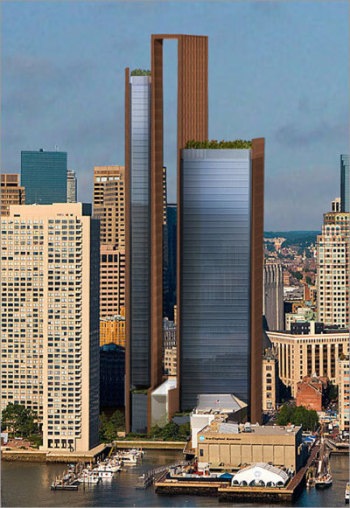“The proposed project is at such wide variance from the applicable state and local permitting requirements currently in force that it simply cannot be constructed as currently designed.’’
That’s the response from Energy and Environmental Affairs Secretary Ian Bowles to Donald J. Chiofaro, founder of The Chiofaro Company, and his plan to redevelopment the parking garage that sits in between the Aquarium site and the Harbor Towers condo development.
Chiofaro’s proposal calls for a 560-foot office tower and a 690-foot residential tower, which would translate to 40 and 59 stories, respectively (see project mock up below from Kohn Pedersen Fox Architects). What’s the City of Boston willing to support? A 200 foot height limit, which is 45 feet higher than current zoning, but well below what Chiofaro needs.
The City versus Chiofaro turmoil was brought to a head at a March 18th Boston Redevelopment Authority (BRA) meeting that focused on development projects along the Rose Kennedy Greenway, following an indirect exchange between Chiofaro and Mayor Thomas M. Menino earlier that day. In the Boston Globe, Chiofaro put out a statement that “he will abandon his proposal to build two skyscrapers near the New England Aquarium unless city officials relax height restrictions and approve buildings tall enough to make the project economically viable”. Menino followed that with on air radio comments that the “Manhattanization” of Boston was not going to happen on his watch.
Let’s think back though, Chiofaro has been in this situation before, when in 1981, Chiofaro began his epic journey to redefine the Boston Harbor skyline with the construction of International Place. 46 and 35 stories in two towers, International Place stands as Boston’s largest office complex and has maintained its position as the city’s premier property since opening in 1987. Is Chiofaro up for another 6 year battle with the city?
Currently, the BRA has not scheduled a public meeting of the Impact Advisory Group for the Harbor Garage Redevelopment, and both Massport and the Federal Aviation Administration have formally expressed their concerns regarding the proposed heights of Chiofaro’s buildings, and both have requested that the heights be reduced.
Why do the buildings need to be so tall? The project is simply not economically feasible otherwise claims Chiofaro. Simplistically, Chiofaro is stating to the City of Boston that he has the money, or will have the money, to fund construction and the economic development that comes with it, something the City may not be in desperate desire for, but still wants, but it must be done in a way that incentivizes Chiofaro to make it happen.
From an economic standpoint, current market indicators point to the fact that such a large-scale development could not be absorbed anyway. However, perhaps Chiofaro is factoring in the lengthy and uphill struggle that developers face in Boston, be it a roof deck or 50-story building, and the cycle of real estate development and the corresponding market fundamentals at the time of construction completion will come together to form a perfect storm, similar to what Chiofaro experienced with International Place.







